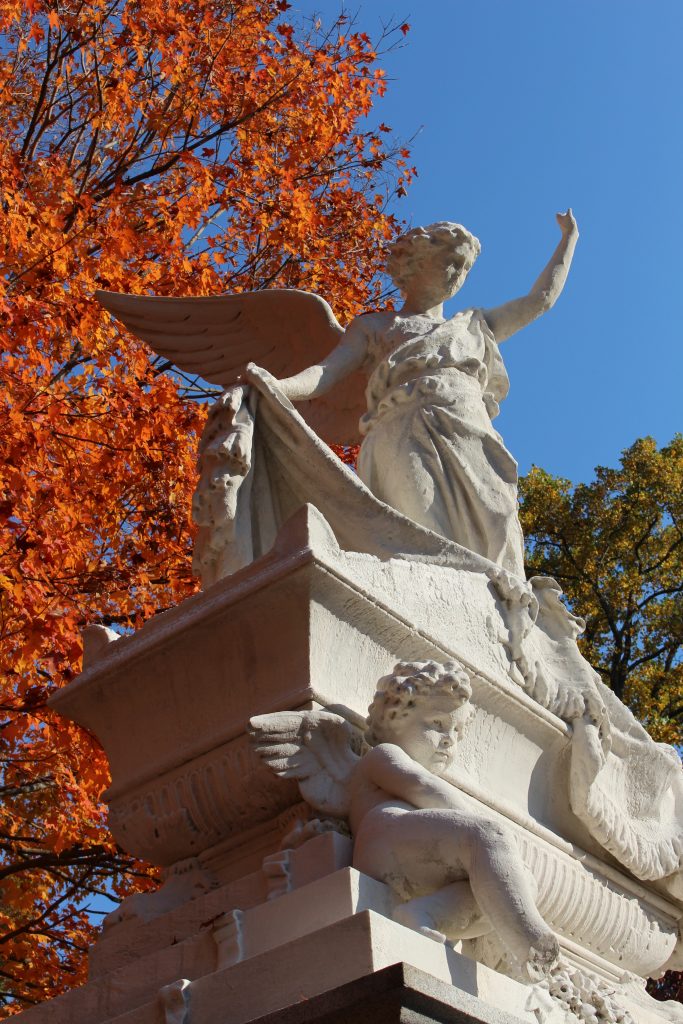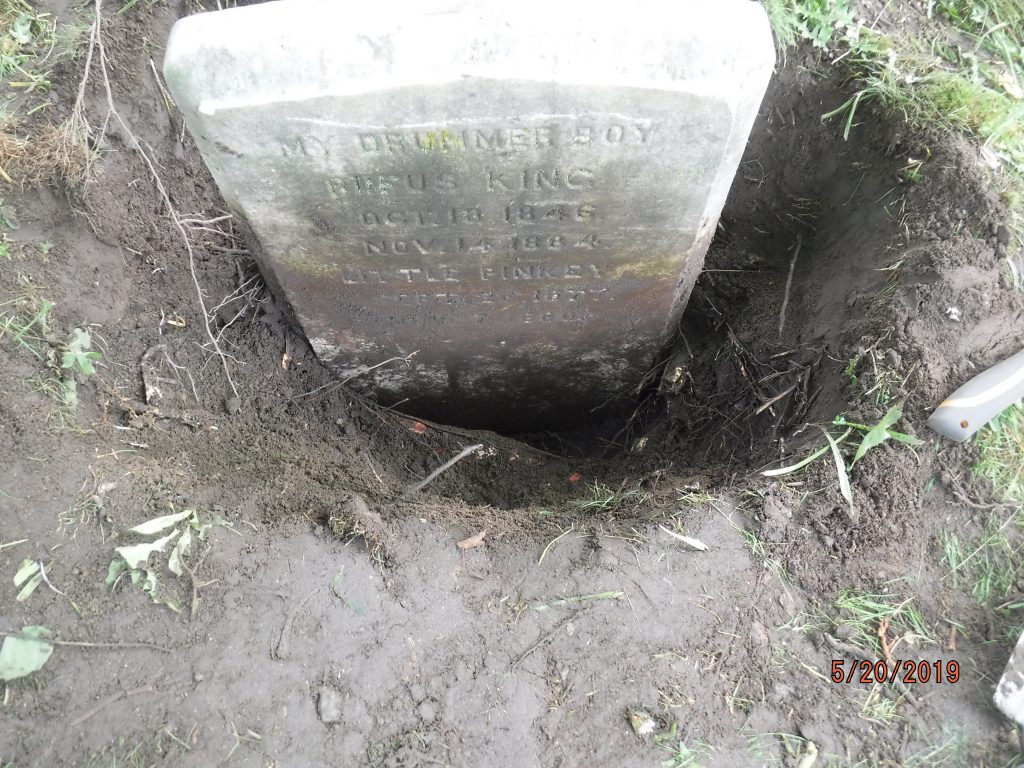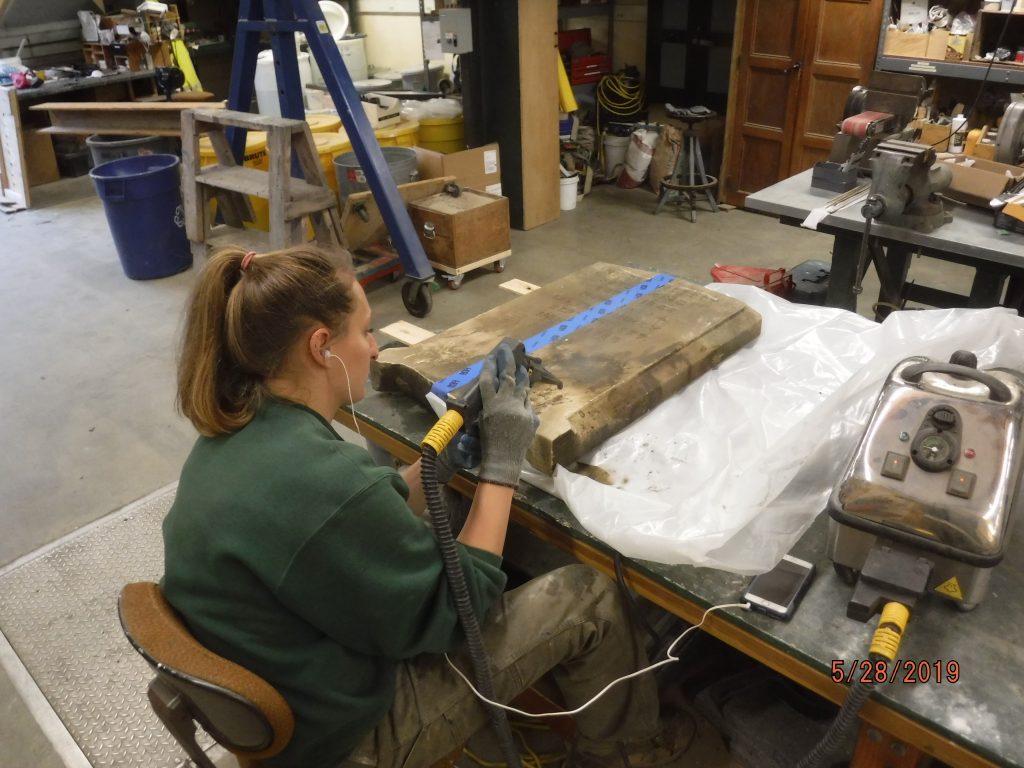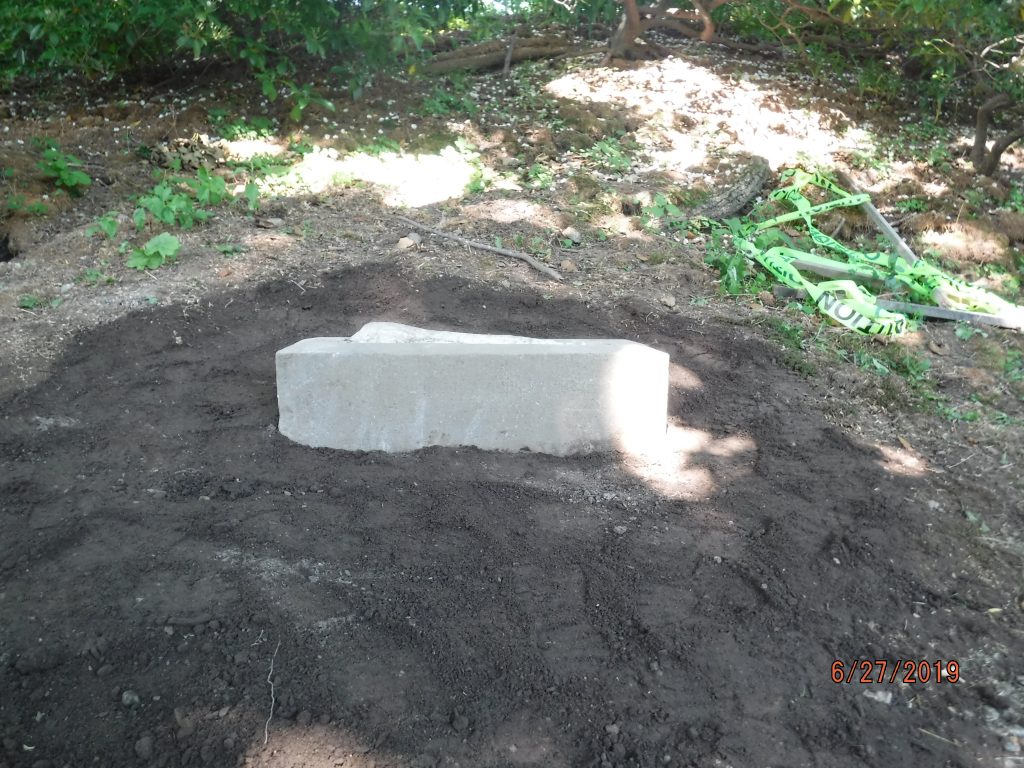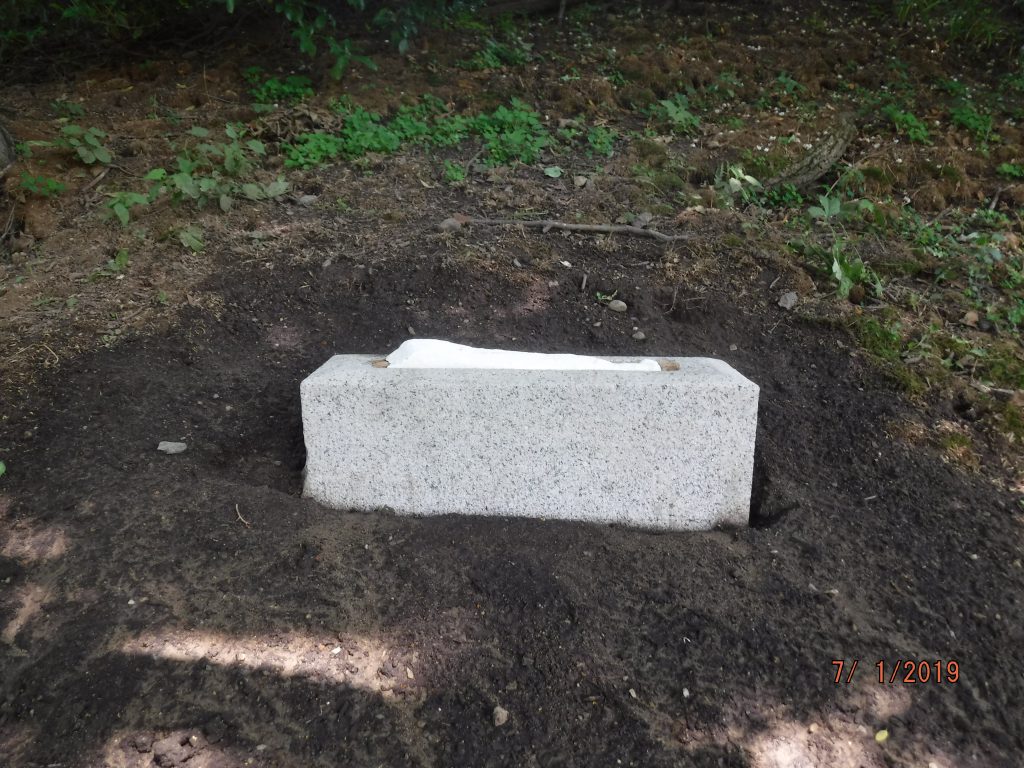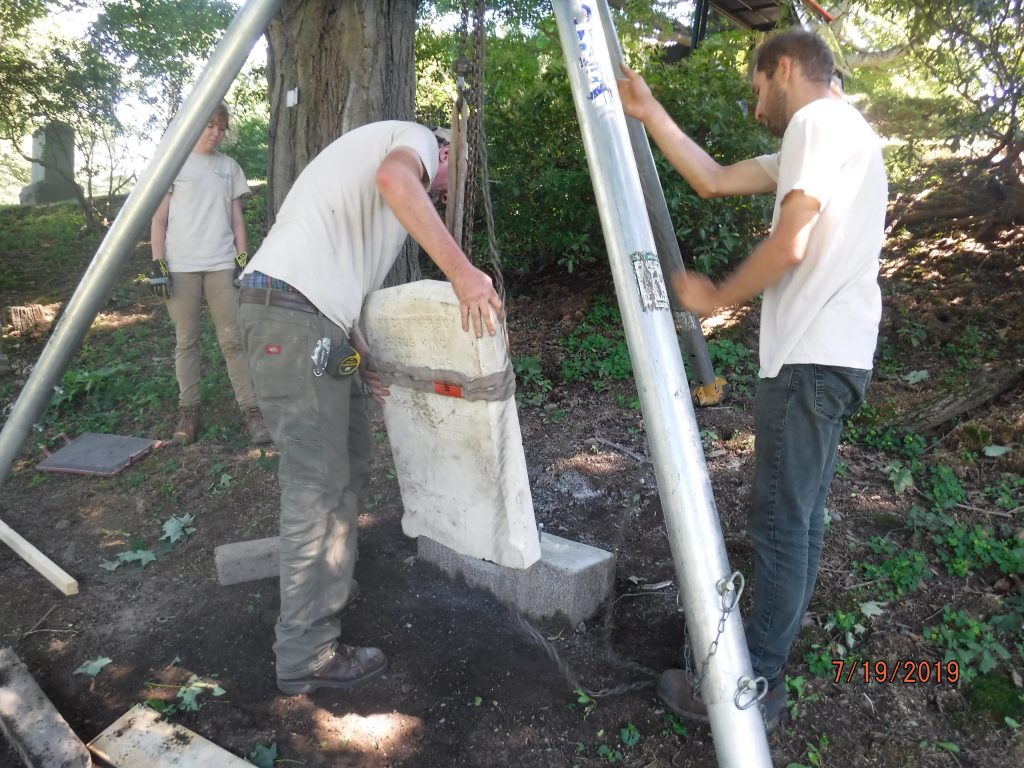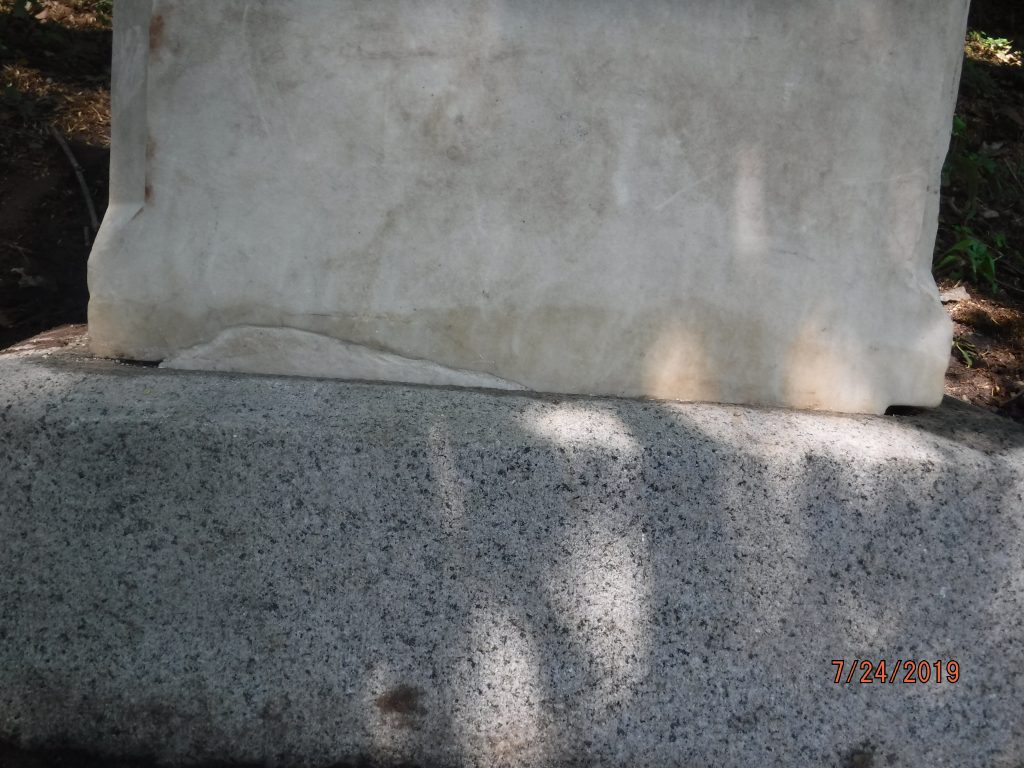Help us Preserve the Scots’ Charitable Fence
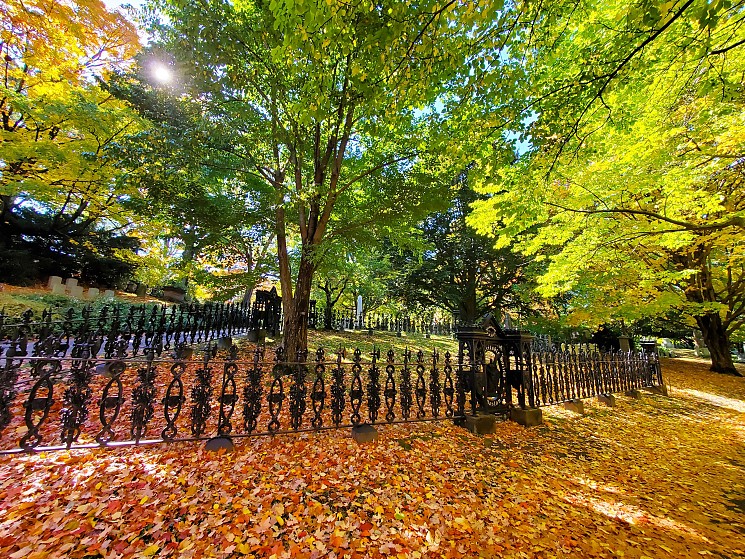
Mount Auburn has received a challenge grant from the National Trust for Historic Preservation for a detailed assessment of our magnificent Scots’ Charitable Society lot fence. This will be the important first step towards preserving one of Mount Auburn’s most unique works of commemorative art.
Read on to learn more about the fence, and help us raise the funds that we need to unlock the grant and start this ambitious project!
Meaningful Design, Unique History
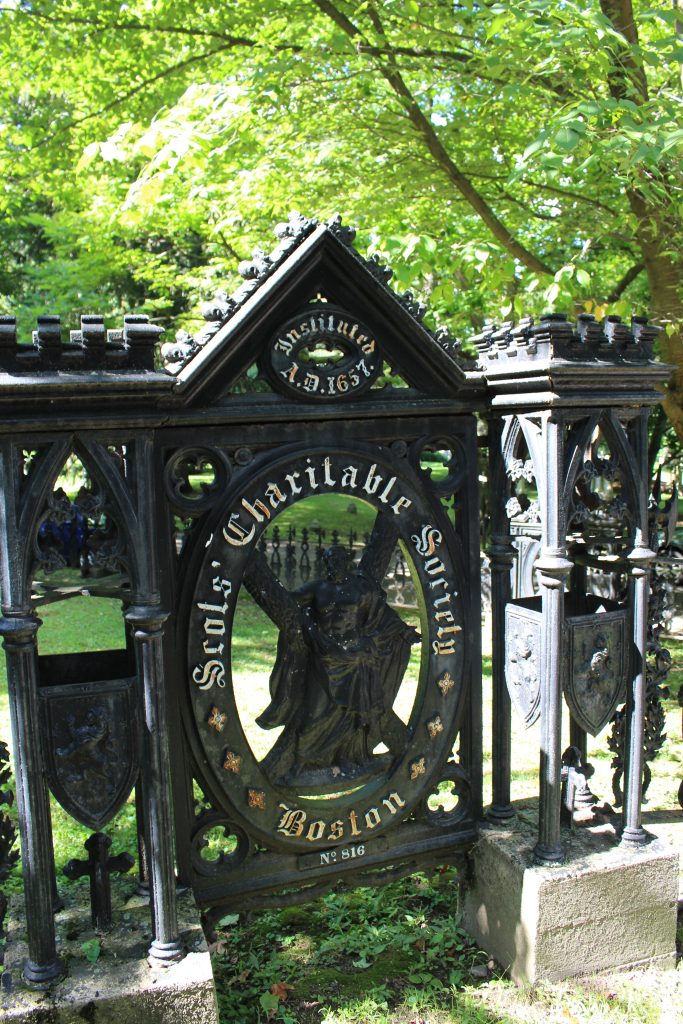
The Scots’ Charitable Society Fence (Lot #816 at the intersection of Fir and Walnut Avenues) is one of the most ornate cast iron fences at Mount Auburn. It was designed by architect Theodore Voelckers circa 1847 and made by David Miller of Boston, a member of the Scots’ Charitable Society. The large fence is adorned with symbols of the Scottish heritage of the people buried in the lot, including the image of St. Andrew, the patron saint of Scotland, as well as thistles, battle axes, rampant lions, and crests.
Purchased in 1841 by the Scots’ Charitable Society for its members, this lot memorializes over 200 people. What makes it unusual is that there are no headstones or grave markers. Instead, the cast iron fence itself is the memorial. At the time, this was a creative exercise in economy. Many working-class people could not afford the high costs of individual lots at Mount Auburn, so the Scots’ Charitable Society lot was a resource for members in need.
Today, the Scots’ Charitable Society lot fence is one of our most beloved, from its remarkable design to the unique history it represents.
Critical Need for Preservation

After so many years of outdoor exposure, the fence needs substantial preservation. The granite bases – which hold up the heavy fence – have suffered severe deterioration, threatening the entire fence’s stability. The fence also has many broken spots that need repair. And its outer coat of paint – the essential layer that protects any cast iron from damage – is wearing thin, so the entire fence needs repainting. We anticipate that the fence will need to be fully dismantled for repair – a complex but essential project to ensure its future.
Before we can preserve the fence, our preservation team needs to determine what the most effective plan will be over the next several years. Hiring preservation architects to conduct an assessment – which we have done for other major projects like Washington Tower and the Egyptian Revival Gateway – is the first step needed.
You can help us preserve this iconic fence! Donate today to help us cover all of the assessment costs and unlock the $3,000 match required for our National Trust grant, and help us build momentum for this ambitious project over the next several years. Thank you for your support!
Learn More: Cast Iron Fences at Mount Auburn
In the early years at Mount Auburn, many proprietors enclosed their lots with iron fences – part of a trend of decorating family lots in a similar fashion to one’s home or front yard. By the 1860s, 1,700 of them dotted our grounds. But the trend of iron fence art was short-lived, and many people in the 1870s began to criticize it for making the Cemetery look too cluttered – like a “crazy quilt.” A movement to remove the existing fences began, and no new fences, granite curbing, or steps were permitted on newly-purchased lots for many decades to follow. Today, Mount Auburn has 62 fences remaining in our landscape – 60 historic and 2 new. Back in 1993, we developed a Master Plan that recognized the importance of preserving early ornamentation of the landscape, and as a result, Mount Auburn has been committed to caring for and preserving the remaining fences.
Ornamenting the Landscape: An Interview with Meg L. Winslow
History of Fence and Curb Removal at Mount Auburn
Donate Here:
Preserving Washington Tower

If there’s one spot people are most likely to remember about Mount Auburn, it’s Washington Tower. At 62-feet tall, the Tower provides a spectacular view of the Boston skyline, and has been one of the most beloved features in our landscape ever since it was built in 1854.
Today, the Tower is in need of preservation. If we want to guarantee that we can keep it open to the public for another century, it will require major work in the coming years.
Thanks to generous support from grants and individual gifts, we were able to complete a preservation assessment of the Tower in 2020. We now have a complete assessment, options for repair and improvements, and estimated budgets to support planning for restoration of this iconic structure.

Further planning will be needed over the next few years before the full preservation begins. But already, the 2020 assessment has shown that there is significant work to be done on the Tower’s masonry. Fortunately, its large blocks of Quincy granite are extremely durable. However, as water has worked its way into the walls from upward-facing joints at the top of the Tower, the stones have shifted – creating opportunities for water to get in. Stopping this cycle of deterioration will require dismantling the top quarter of the Tower and rebuilding it using the existing granite. Additionally, the wood tracery windows will be repaired or reconstructed, new lighting installed, and safety improvements made to the stair rail. Finally, the architect presented potential plans for increasing the accessibility of the site, including a graded path and handicap parking along the road. Stay tuned for more updates on the launch of this multi-year preservation initiative!
New Conservation Treatment for the Magnificent Whitney Monument
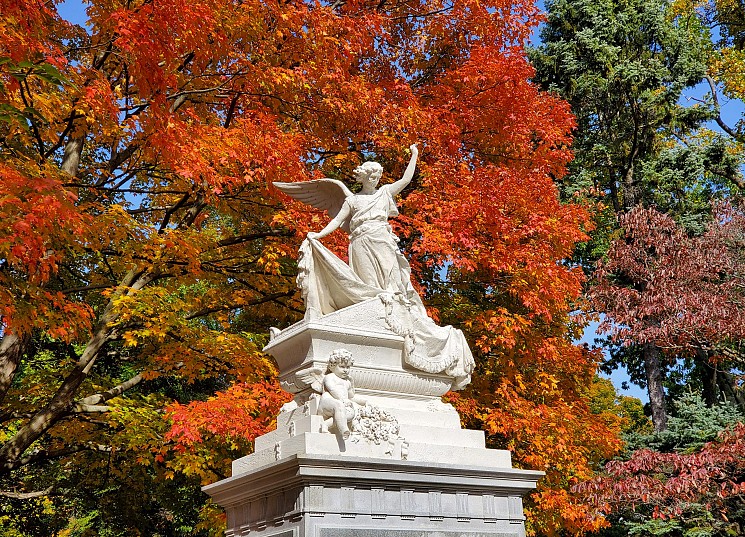
On a beautiful October day, conservators completed treatment of the magnificent 1883 Whitney Monument on Oriole path in Mount Auburn. It was perfect timing. The twenty-two-foot-high monument created by Italian sculptor Nicola Cantalamessa-Papotti was set off by a background of vibrant orange and gold leaves of the nearby sugar maple.
Conservators from Daedalus Inc. had assessed the condition of the Whitney Monument, designated as one of Mount Auburn’s thirty most significant monuments, as a top priority for treatment. Viewed from a distance, the memorial appeared to be in better shape than it was, but closer inspection revealed an alarming degree of degradation.
The marble surface, once smooth and lustrous, contained an extensive network of fine cracks, larger fissures, and even deeper vertical cracks. In addition, the surface showed signs of disaggregation, the loss of cohesion between the grains of the stone that over time had created a highly eroded surface of dramatic bumps and ridges. Typical of monuments in an outdoor environment, the entire exposed surface was heavily soiled with areas of green algae and decayed lichen. Black crusts of gypsum leaching from the marble appeared in the recesses and protected areas of the white marble, especially in the deep folds of the drapery and in the flowers. Sadly, extensive losses dating from the early 20th century included the angel’s left wing and hand, and the little foot of the putto (cherub figure).
Daedalus Inc. conservator Joshua Craine, Mount Auburn’s Vice-President of Preservation and Facilities Gus Fraser, and Curator Meg Winslow had to determine the best method of treating the severely eroded marble. They made the decision to wash and stabilize the monument, but not to undertake additional restoration of elements such as the wing and the foot. Most significantly, the team chose to apply a shelter coat to protect the surface of the monument: the first time a treatment of this kind would be attempted at Mount Auburn.
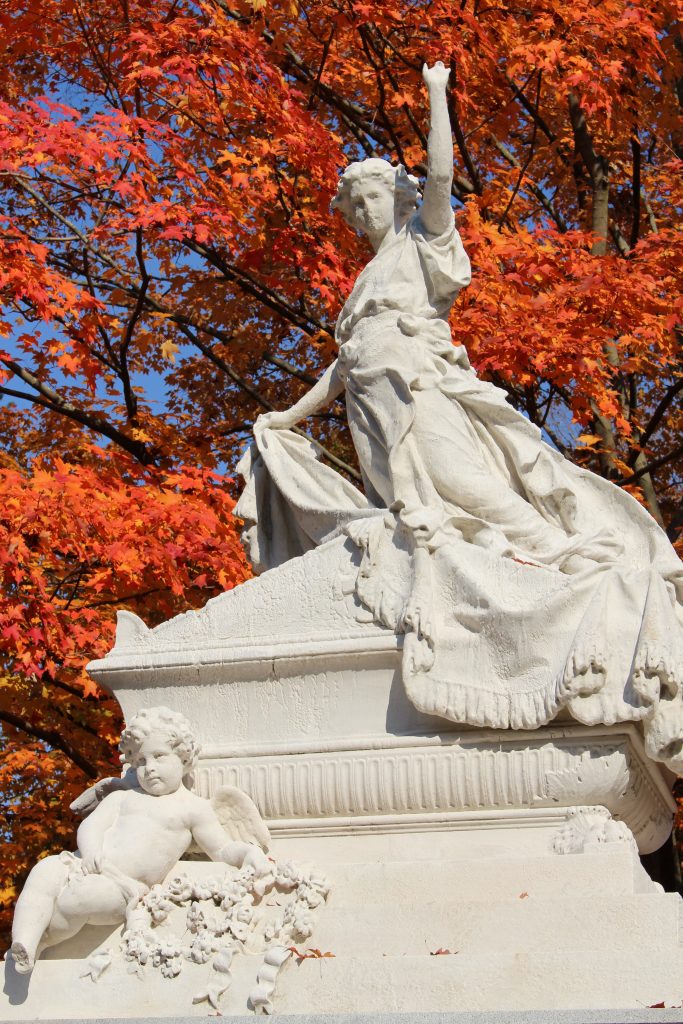
The shelter coat is a mix of hydraulic lime mortar with very fine aggregate, diluted with water and tinted to match the marble color of the monument. The fine aggregate included in the mix binds with the lime, creating a matrix that enhances both permeability and durability. The mix is applied with a brush, and when cured, results in a breathable coating that is sacrificial in nature, meaning that over time it, and not the original surface of the monument, will erode. Mixing, applying, and curing the coating requires time and skill, but “as long as it’s done properly, it’s totally reversible and re-treatable,” explains Craine.
“The severely eroded condition of the monument prompted the team to consider a sacrificial shelter coat to protect the surface rather than a more invasive approach of a chemical consolidant,” says Fraser. “With Josh’s continued help, we will monitor the condition of the coating and retreat as necessary.”

Prior to applying the shelter coat, the entire monument was carefully washed to remove biological growth and atmospheric staining. Craine removed the areas of gypsum crust with a hand-held laser, instead of chemicals or brushing. After cleaning the monument, he applied the protective shelter coating with a thick, sash brush, daubing it on to fill the recesses of the sculpture and create an even coat. The grit included in the mixture helped the coating adhere to the surface and recede into the grooves of the carving.
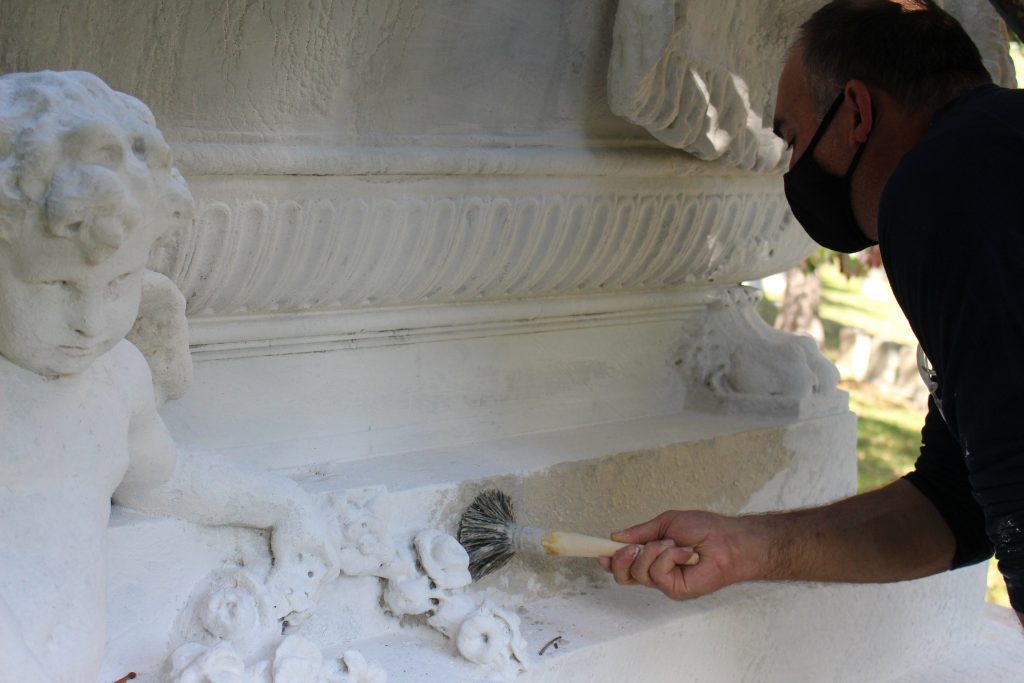
The treatment required wrapping the monument in a layer of canvas and then in a sheet of plastic to protect the coating and ensure a proper cure. Once or twice a day, Craine removed the extensive wrapping to inspect the progress and fill areas that still needed coating. “The art,” explains Craine, “is knowing when to stop.” Coating the sculpture, touching it up, and keeping it wet proved time consuming and occurred over the course of five to six days. Fortunately, the work took place under clear skies and low humidity.
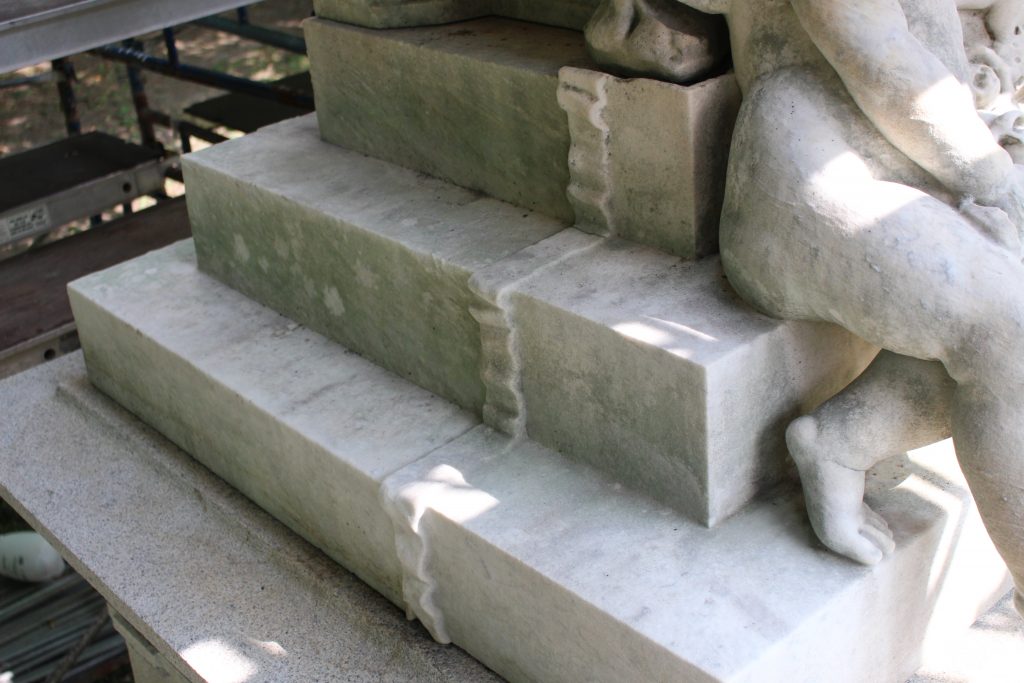
The color now appears creamy and bright, especially when compared to the condition before treatment, but similar to other marble monuments at Mount Auburn that have recently been washed. “There’s trepidation with every conservation project, even when working with the most skilled conservator like Josh,” explains Winslow, “so you can imagine we’re thrilled to see the results of the project. In the early morning light, the Whitney monument just takes your breath away.” Craine concludes, “We’ve saved it to some degree and given it a bit more life.” Viewed from a distance, the spirit and uplifting movement of the monument remains intact.
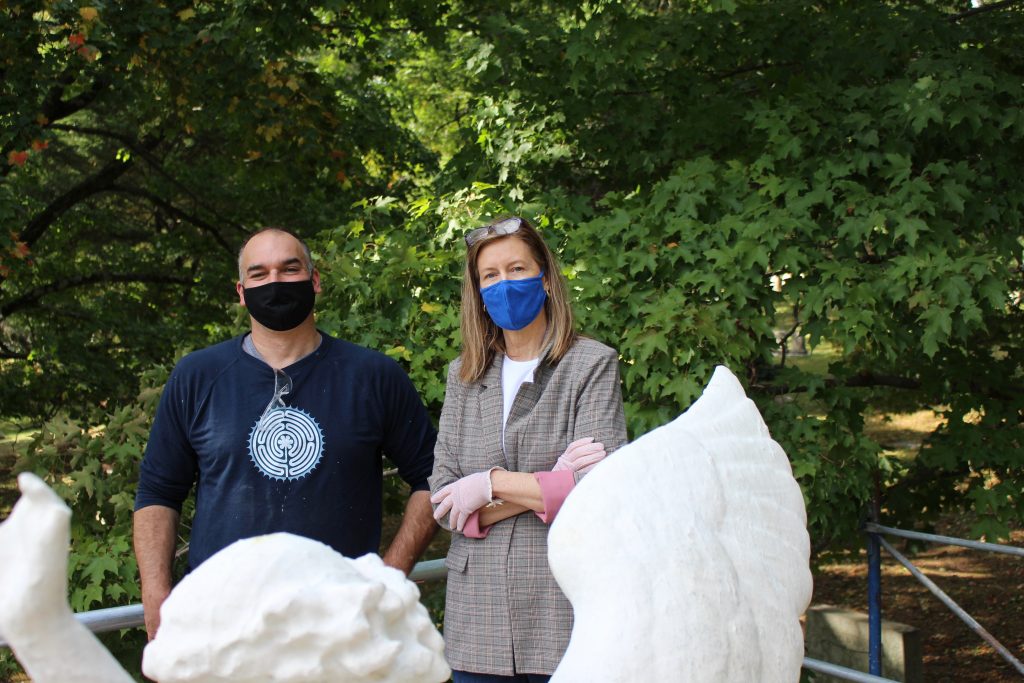
Learn more about the Whitney Monument, the artist Nicola Cantalamessa-Papotti, and the Whitney family.
DRUMMER BOY: A Civil War Veteran
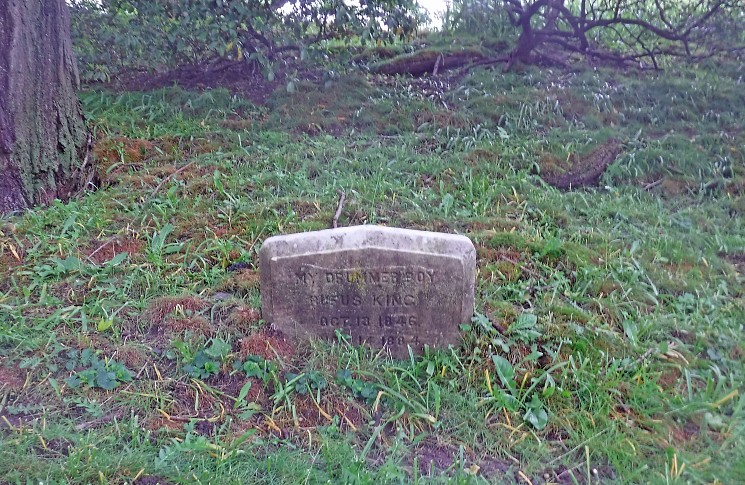
Mount Auburn was awarded a grant by the Massachusetts State Historical Records Advisory Board (MA SHRAB) to preserve selected veterans’ monuments in 2019. One of the monuments chosen for treatment memorializes Rufus King, a Civil War soldier whose role in the Union Army is made clear by the words “MY DRUMMER BOY” at the top of his headstone. This unique inscription made the monument an excellent candidate for the MA SHRAB grant, as did its poor condition (Figure 1 above). Positioned at the top of a hill, it was leaning forward and covered in biological growth, dirt, and residue from atmospheric pollutants (Figure 2 below). We originally described the monument as “small” in the project proposal, because as far as we knew it was only a foot tall. However, preservation work quickly proved that there was much more to the headstone than originally assumed.
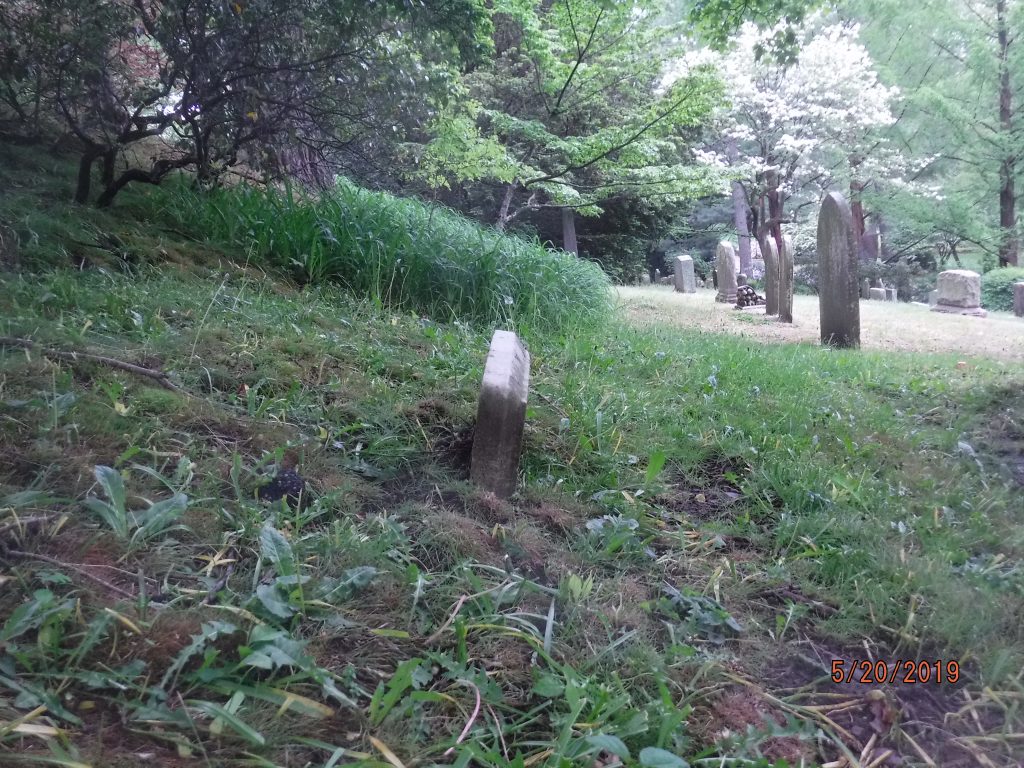
Our first step in preserving the monument was to excavate it. It had been clear from the start that some of the headstone had been buried as the hillside eroded, but we were surprised to find as much as twenty inches of marble below grade (Figure 3 below left). The monument had been anchored in its crooked position by several large tree roots, which we cut away so that we could remove it from the ground. Once we unearthed it, we discovered a second unique inscription; the headstone memorialized not only “Drummer Boy” Rufus King, but a young woman nicknamed “Little Pinkey” (Gertrude King). We also noticed that the bottom edge of the headstone was jagged. This suggested that it had broken at some point in the past, and that there had been a base that was discarded after the damage was done (Figure 4 below right).
We brought the monument into Mount Auburn’s preservation workshop, where we washed it with a steam-cleaner (Figure 5 below). This treatment successfully brought the marble from a grayish color back to its original white (Figure 6 below). Next, the ground where the monument had been located was excavated in order to make space for a foundation. One reason that Mount Auburn remains beautiful and safe almost two hundred years after its consecration is the fact that each monument is required to sit on a four-foot foundation. These foundations help prevent the headstones from shifting and leaning over time. However, occasionally we work on monuments like the King headstone that are missing foundations. As we removed four feet of earth and tree roots to pour the concrete, we were surprised yet again; the original base was discovered on its side about two-and-a-half feet below grade (Figure 7 below). Its many years underground had kept the broken marble on its top face from wearing away, so it promised to be a near-perfect fit with the headstone’s corresponding edge (Figure 8). After carefully removing the base from the ground, we dug the hole to its full depth and poured a new foundation (Figure 9 below). When the concrete had set, we cleaned the bottom of the base, set it on the foundation with Portland cement mortar, and backfilled the hole (Figures 10 and 11 below). We then cleaned the granite base with a power-washer (Figure 12 below).
Due to its tall, thin shape, we decided to give the monument extra stability by putting pins into the headstone at the break. We carefully measured the appropriate location for two holes in each face of the marble and drilled accordingly. Then we cut two stainless steel pins and anchored them into the holes in the lower piece of marble with epoxy, a very strong adhesive (Figure 13 below). Finally, we lowered the headstone into place with a gantry tripod, using more epoxy to glue the two pieces of marble together (Figure 14 below).
Once the epoxy set, we moved on to the finishing touches. The crack where the marble had broken was filled with a mixture of B72 resin and marble dust, which was combined with a tiny pinch of yellow ochre pigment to create a paste the same color as the marble (Figure 15 below). In addition to improving the monument’s appearance, this fill will prevent water from entering the crack and damaging the stone during the freeze-thaw process. The headstone had become slightly soiled again during the preceding preservation treatments, so the dirt was removed as thoroughly as possible with Vulpex Liquid Soap, a restoration cleaner. Finally, we scrubbed and sprayed the marble with D/2 Biological Solution. D/2 works with the wind, the rain, and the sun’s UV rays to clean marble over the course of weeks or months, so the monument will look even better in the near future than it does now (Figure 16 below).
The King monument is a quintessential example of the crucial role preservation plays at Mount Auburn. The headstone tells stories not only about the Civil War and the King family, but also about past trends in funerary art and Cemetery practices regarding monument damage. If we had not been able to preserve it, much of this information would have stayed buried underground. Each preservation project adds to Mount Auburn’s historic significance and the richness of the stories we can tell.
Please help us raise the remaining funds needed to support the 2019 preservation of our veterans’ monuments with a gift to Monument Preservation. Thank you for your support!
